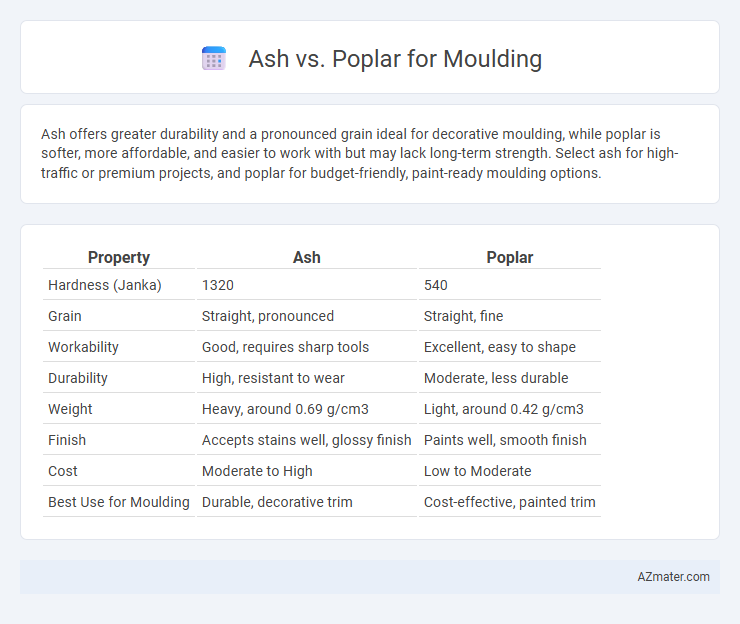Ash offers greater durability and a pronounced grain ideal for decorative moulding, while poplar is softer, more affordable, and easier to work with but may lack long-term strength. Select ash for high-traffic or premium projects, and poplar for budget-friendly, paint-ready moulding options.
Table of Comparison
| Property | Ash | Poplar |
|---|---|---|
| Hardness (Janka) | 1320 | 540 |
| Grain | Straight, pronounced | Straight, fine |
| Workability | Good, requires sharp tools | Excellent, easy to shape |
| Durability | High, resistant to wear | Moderate, less durable |
| Weight | Heavy, around 0.69 g/cm3 | Light, around 0.42 g/cm3 |
| Finish | Accepts stains well, glossy finish | Paints well, smooth finish |
| Cost | Moderate to High | Low to Moderate |
| Best Use for Moulding | Durable, decorative trim | Cost-effective, painted trim |
Introduction to Wood Choices for Moulding
Ash and poplar are popular wood choices for moulding due to their distinct characteristics and workability. Ash offers a strong, durable grain that is ideal for high-traffic areas and provides a natural, attractive finish, while poplar is softer, easier to machine, and takes paint exceptionally well, making it a cost-effective option for painted mouldings. Selecting between ash and poplar depends on the desired aesthetic, durability requirements, and finishing preferences for interior woodwork.
Key Characteristics of Ash and Poplar
Ash wood exhibits exceptional strength, durability, and a distinctive grain pattern, making it ideal for moulding that requires both aesthetic appeal and toughness. Poplar, conversely, is lighter, softer, and easier to machine, offering a more uniform texture and a smooth surface that accepts paint well for versatile moulding applications. Both woods balance cost-effectiveness and workability, but ash is preferable for high-traffic or load-bearing mouldings, while poplar suits decorative or painted finishes.
Strength and Durability Comparison
Ash wood exhibits superior strength and shock resistance compared to poplar, making it a preferred choice for moulding in high-impact areas. Poplar, while less dense and durable, offers ease of machining and cost-effectiveness but may wear faster under heavy use. Selecting ash moulding ensures enhanced durability and long-term performance, particularly in structural or frequently touched applications.
Workability and Machining Differences
Ash offers superior workability compared to poplar due to its open grain structure, allowing for smoother shaping and sanding during moulding projects. Poplar, while softer and easier to machine with less wear on tools, tends to have a less attractive grain and may require additional finishing efforts. The hardness of ash provides more durability and a cleaner edge in detailed machining, making it preferable for high-quality mouldings where precision is critical.
Appearance and Grain Patterns
Ash moulding showcases a light, creamy color with a straight, pronounced grain pattern that enhances its natural texture, making it ideal for projects seeking a clean and uniform look. Poplar moulding typically features a softer, pale yellow to greenish hue with a fine, more subtle grain, providing a smoother and less textured appearance suited for painted finishes. Both woods offer distinct aesthetic qualities, with ash emphasizing bold grain patterns and poplar delivering a more understated surface.
Cost and Availability Analysis
Ash moulding offers a balance of moderate cost and wide availability, making it a practical choice for many woodworking projects. Poplar moulding tends to be more affordable due to faster growth rates and abundant supply, but its availability can vary regionally. Cost analysis reveals that Ash is generally priced higher than Poplar, reflecting its greater density and durability advantages in structural applications.
Finishing and Staining Qualities
Ash offers a smooth, consistent grain that accepts stains evenly, resulting in a rich, uniform finish ideal for detailed moulding work. Poplar, known for its fine and straight grain, stains well but often requires a pre-conditioner to prevent blotchiness and achieve a more even appearance. Both woods provide good finishing qualities, but ash tends to yield a more vibrant, natural wood tone, while poplar is often chosen for painted mouldings due to its smooth surface.
Environmental Impact and Sustainability
Ash moulding is prized for its durability but often involves faster harvesting cycles that can stress natural forests, whereas poplar offers a more sustainable option due to its rapid growth and efficient carbon sequestration. Poplar's lightweight properties reduce transportation emissions, enhancing its environmental benefits compared to denser hardwoods like ash. Choosing poplar for moulding aligns with sustainable forestry practices, as it supports renewable resource management and reduces ecological footprints.
Best Applications for Ash and Poplar in Moulding
Ash is ideal for moulding in high-traffic areas due to its exceptional hardness, durability, and attractive grain pattern, making it perfect for baseboards, chair rails, and door casings where strength and aesthetics are essential. Poplar offers a cost-effective option with a smooth texture and easy workability, well-suited for painted moulding applications like crown moulding and window trim where intricate profiles and a consistent finish are desired. The choice between ash and poplar hinges on balancing durability needs with budget constraints and desired visual effects in interior architectural moulding.
Choosing the Right Wood for Your Moulding Project
Ash offers superior strength and durability, making it ideal for high-traffic areas or structural moulding that requires resistance to dents and wear. Poplar, with its fine grain and ease of painting, provides a cost-effective solution perfect for decorative moulding and detailed trim work where a smooth finish is essential. Selecting between Ash and Poplar depends on the project's demands for hardness versus finish quality, balancing durability with aesthetic flexibility.

Infographic: Ash vs Poplar for Moulding
 azmater.com
azmater.com